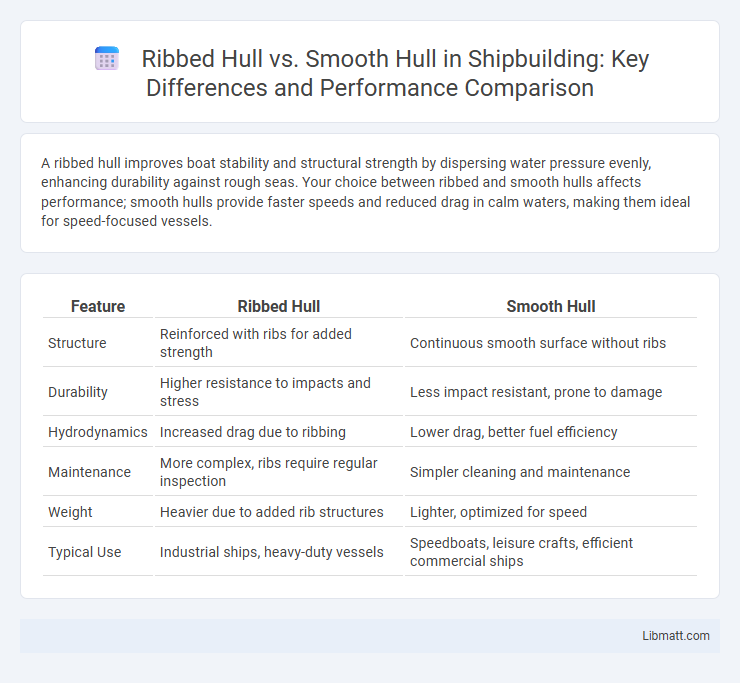A ribbed hull improves boat stability and structural strength by dispersing water pressure evenly, enhancing durability against rough seas. Your choice between ribbed and smooth hulls affects performance; smooth hulls provide faster speeds and reduced drag in calm waters, making them ideal for speed-focused vessels.
Table of Comparison
| Feature | Ribbed Hull | Smooth Hull |
|---|---|---|
| Structure | Reinforced with ribs for added strength | Continuous smooth surface without ribs |
| Durability | Higher resistance to impacts and stress | Less impact resistant, prone to damage |
| Hydrodynamics | Increased drag due to ribbing | Lower drag, better fuel efficiency |
| Maintenance | More complex, ribs require regular inspection | Simpler cleaning and maintenance |
| Weight | Heavier due to added rib structures | Lighter, optimized for speed |
| Typical Use | Industrial ships, heavy-duty vessels | Speedboats, leisure crafts, efficient commercial ships |
Introduction to Hull Design
Ribbed hulls feature raised structural reinforcements that enhance durability and impact resistance, making them ideal for rough waters and heavy-duty applications. Smooth hulls offer streamlined surfaces that reduce hydrodynamic drag, improving speed and fuel efficiency in calmer conditions. Hull design selection balances factors such as vessel purpose, water conditions, and performance requirements to optimize stability and operational efficiency.
What is a Ribbed Hull?
A ribbed hull features a series of structural ribs or reinforcements running along the interior or exterior, enhancing the vessel's strength and durability compared to a smooth hull. This design improves resistance to impacts and increases rigidity, making it ideal for boats that operate in rough waters or need extra support. You benefit from a ribbed hull's enhanced stability and longevity, which contributes to better performance and safety on the water.
What is a Smooth Hull?
A smooth hull refers to a boat or ship's exterior surface that is uniformly flat and free from grooves or ridges, designed to reduce water resistance and enhance speed and fuel efficiency. Unlike ribbed hulls, which have structural reinforcements creating a textured surface, smooth hulls provide less drag and allow for quieter movement through water. These hulls are preferred in performance vessels where agility and speed are critical factors.
Hydrodynamics: Ribbed vs Smooth Hull
Ribbed hulls enhance hydrodynamics by improving water flow attachment, reducing drag and increasing stability in turbulent waters compared to smooth hulls. Smooth hulls minimize resistance in calm conditions by providing a sleek surface, allowing for faster speeds and greater fuel efficiency. Your choice depends on the typical water conditions and desired performance, with ribbed hulls better suited for rough seas and smooth hulls ideal for speed and efficiency.
Stability and Handling Differences
Ribbed hulls provide enhanced stability by improving water displacement and reducing slippage, offering better grip and control in rough waters compared to smooth hulls. Smooth hulls excel in handling at higher speeds due to less water resistance and a more streamlined surface, resulting in faster acceleration and maneuverability. Choosing between ribbed and smooth hulls depends on the intended use, with ribbed designs favoring stability in turbulent conditions and smooth hulls prioritizing speed and agile handling.
Durability and Maintenance
Ribbed hulls offer enhanced durability due to their reinforced structure, which resists impacts and abrasions better than smooth hulls. Smooth hulls require less frequent cleaning and reduce drag, resulting in easier maintenance and improved fuel efficiency. Your choice between ribbed and smooth hulls depends on balancing durability needs with maintenance preferences.
Performance in Various Water Conditions
Ribbed hulls enhance your vessel's stability and maneuverability in rough or choppy waters by increasing friction and reducing slipping, making them ideal for turbulent conditions. Smooth hulls excel in calm, flat waters, offering less resistance and higher speeds due to streamlined surfaces that minimize drag. Choosing between ribbed and smooth hulls depends on the primary water conditions you plan to navigate for optimal performance.
Cost Comparison: Ribbed vs Smooth
Ribbed hulls typically incur higher initial manufacturing costs due to the complex molding process and added material strength compared to smooth hulls, which are simpler and cheaper to produce. Maintenance expenses for ribbed hulls can also be higher because the grooves trap dirt and marine growth, requiring more frequent cleaning and antifouling treatments. Your choice between ribbed and smooth hulls should consider both upfront investment and ongoing upkeep to balance overall cost efficiency.
Choosing the Right Hull for Your Needs
Ribbed hulls offer enhanced durability and improved grip on water surfaces, making them ideal for rough conditions and heavy-duty use, while smooth hulls provide less drag for increased speed and fuel efficiency in calmer waters. Selecting the right hull depends on your primary water activities; ribbed hulls are suited for stability and protection during fishing or off-shore adventures, whereas smooth hulls excel in recreational boating and watersports that require speed. Understanding your typical water environment and performance needs ensures an optimal hull choice for safety and efficiency.
Conclusion: Ribbed or Smooth Hull?
Choosing between a ribbed hull and a smooth hull depends on the vessel's intended use and performance requirements. Ribbed hulls provide enhanced structural strength and improved impact resistance, ideal for rough waters and heavy-duty operations. Smooth hulls offer reduced drag and increased speed efficiency, which benefits leisure crafts and racing boats focused on maximizing velocity and fuel economy.
Ribbed hull vs smooth hull Infographic

 libmatt.com
libmatt.com